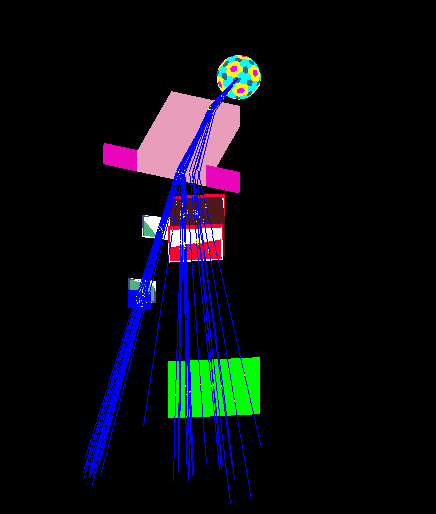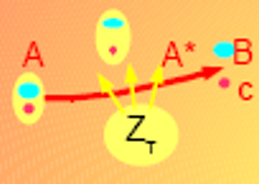DESCRIPTION
Coulomb dissociation of 27P
Setup simulated with GEANT4.
We performed a 27P C.D. experiment at GSI, Darmstadt (28 May-5 June 2007) using the ALADIN-LAND setup which allows complete-kinematic studies. The incoming beam and fragments were identified using energy-loss and time-of-flight measurements and the trajectories measured by different tracking detectors. A scheme of the setup can be seen in a link below. 36Ar at 680 AMeV was used as primary beam; a thicker reaction target with respect to a previous experiment performed in RIKEN (Japan) to study the same reaction was used. We expect to get higher statistics than in that experiment in RIKEN being able to resolve some resonances that were seen there with moderate resolution. The direct capture contribution will be much larger in our case. The analysis of the obtained data is currently in the calibration phase.
Astrophysical motivation


ESA's Integral observatory has detected the presence of radioactive 26Al in the interstellar medium (central regions of the Milky Way) by measuring the 1.809 MeV γ rays coming from the decay of 26gAl. These observations confirm that the production of new heavy nuclei is an ongoing process. The amount of 26Al (rare isotope) produced is suprisingly high. It is clear that the nuclear physics of isotopes around 26Al such as 27P or 26Si is very interesting. The reaction 26Si(p,γ 27P is relevant to the synthesis of 26Al. 26Al γ decays to an isomeric state of 26Mg which then decays into the ground state of 26Mg (no γ -ray emitted). The 1.809 MeV γ -line is only emitted by the γ decay of 26Al to the ground state. At high temperatures there is equilibrium between the isomeric state (0+) and the ground state (5+). The process 26Si(p,γ) 27P gives information about the production of the isomeric state, that means information of the ground state in the equilibrium.

Synthesis and decay of 26Al.
Coulomb dissociation technique.
{
In the coulomb dissociation process an ion A bombards a high-Z target A is Coulomb excited to A* decaying into B+c In the reaction A(γ,c)B a virtual photon produced by the Coulomb field of the target is absorbed. The C.D. Method is mostly suited when the target is not stable so direct reactions cannot be studied easily and also when the binding energy is small to ensure dominant Coulomb character of the reaction. The use of relativistic energies allows to work with thicker targets.
PARTICIPANTS
Saúl Beceiro (1), K. Sümmerer (2), D. Cortina-Gil (1), H. Alvarez-Pol (1), T. Aumann (2), K. Behr (2), K. Boretzky (2), E. Casarejos (1), A. Chatillon (2), U. Datta-Pramanik (3), Z. Elekes (4), Z. Fulop (4), D. Galaviz (5), H. Geissel (2), S. Giron (2), U. Greife (6), F. Hammache (7), M. Heil (2), J. Hoffman (2), H. Johansson (8), C. Karagiannis (2), O. Kiselev (2), N. Kurz (2), K. Larsson (2), T. Le Bleis (2), Y. Litvinov (2), K. Mahata (2), C. Muentz (9), C. Nociforo (2), W. Ott (2), S. Paschalis (10), W. Prokopowicz (11) , C. Rodríguez-Tajes (1), D. Rossi (12), H. Simon (2), M. Stanoiu (2), J. Stroth (9), S. Typel (13), A. Wagner (14), F. Wamers (2), H. Weick (2), C. Wimmer (9).
(1) Universidade de Santiago de Compostela, Spain, (2) GSI, Gesellschaft für Schwerionenforschung, Germany, (3) SINP (India), (4) ATOMKI (Debrecen), (5) CSIC (Madrid), (6) Colorado School of Mines (USA), (7) IPN Orsay (France), (8) Chalmers I.T. (Sweeden), (9) Uni. Frankfurt (Germany), (10) Uni Liverpool (UK), (11) Uni Krakow (Poland), (12)University of Mainz (Germany), (13) GANIL (France), (14) FZ Rossendorf (Germany)



